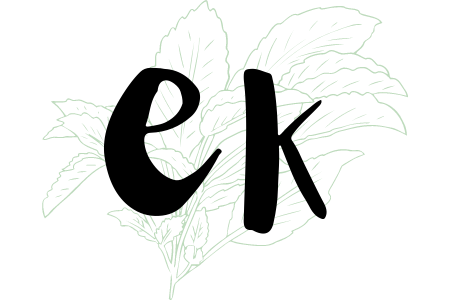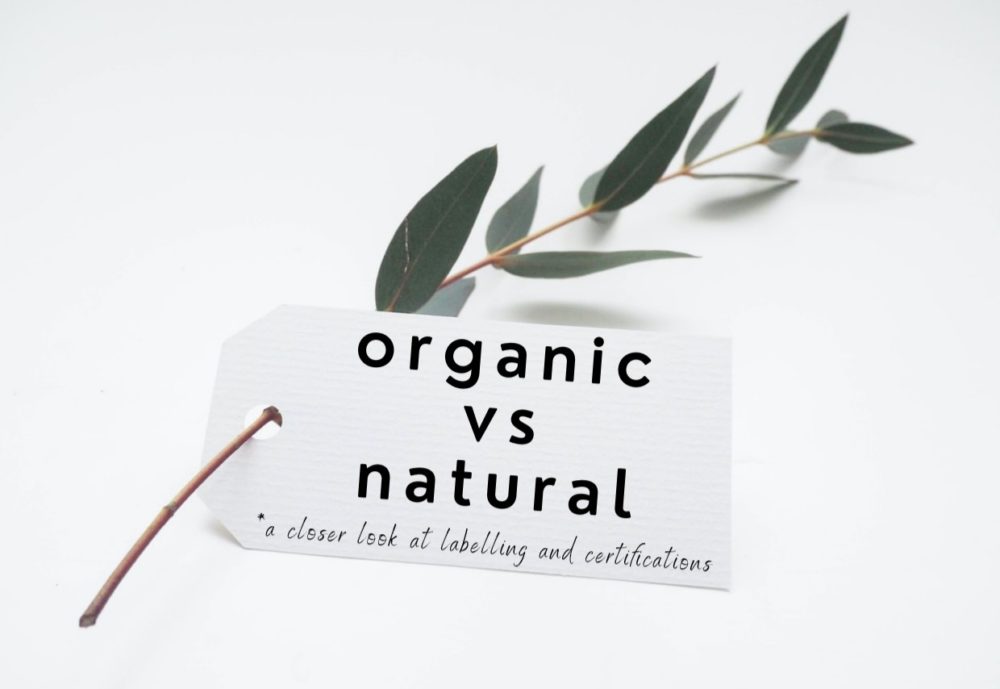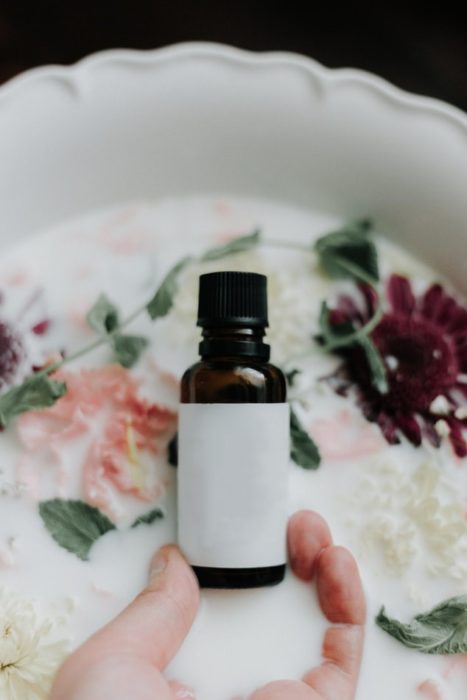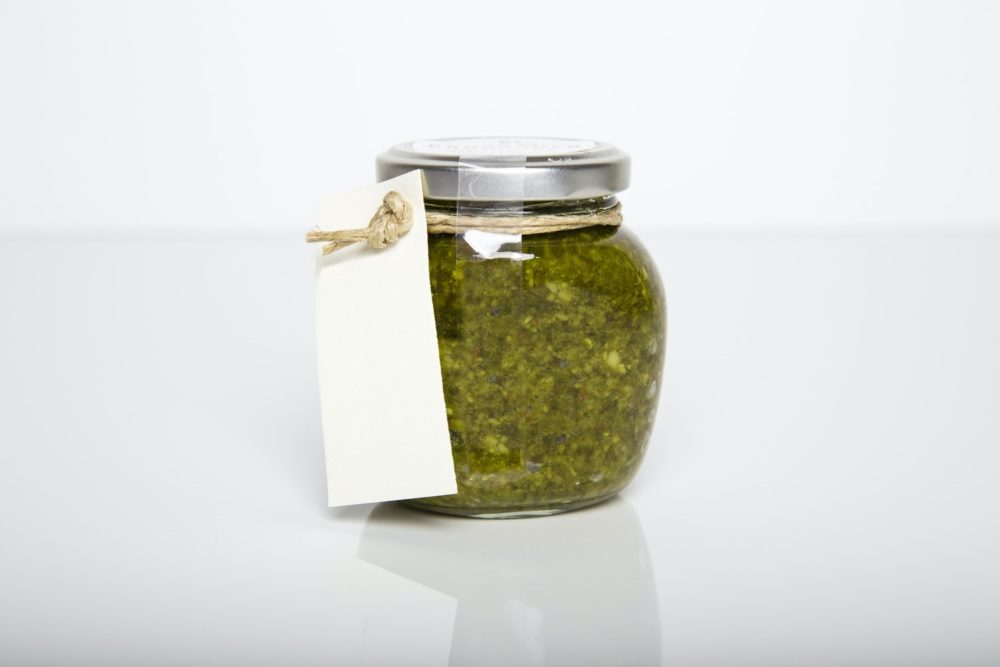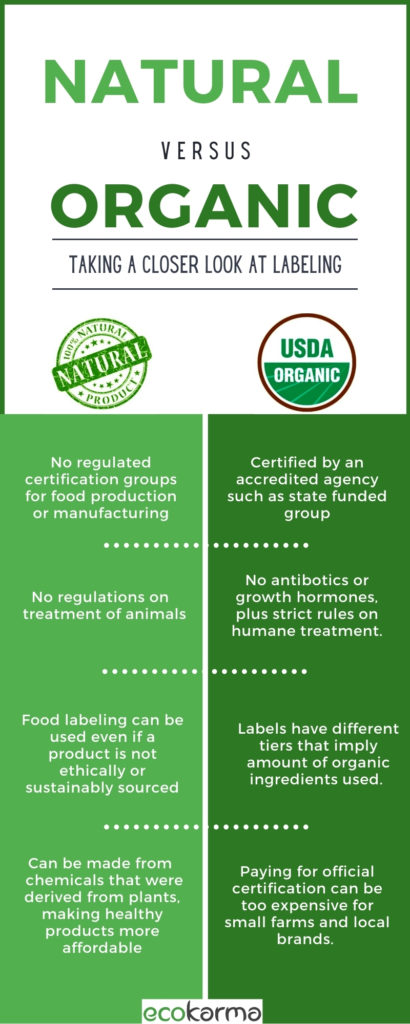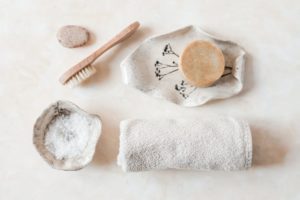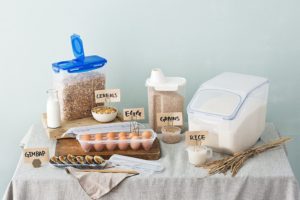If natural isn’t any better than a conventionally produced product and organic doesn’t mean 100% organic, why do we even bother with labels at all? Natural and organic labeling is supposed to help us make better and more humane food and skincare choices, but all this nuanced greenwashing and faux labeling is just head-spinning. Natural vs. organic certification deserves a closer look.
We decided it was time to break it down for you. It turns out, in the United States, “natural” food and skincare labeling is the least regulated label out there, and “organic” applies to products that aren’t entirely organic. Even so, you’ll find that the use of “organic” on labels hits the mark far and above anything else. Let’s take a closer look at the difference between organic and natural product certifications.
Natural vs. Organic Comparison Table
| Food Production | Natural | Organic |
|---|---|---|
| CERTIFICATIONS & DIFFERENCES | –NO Regulated or mandated certification groups on food production –NO Added colors, flavors, synthetic substances –CAN HAVE Chemically modified ingredients and use pesticides | –MUST BE Certified by a private, state, or internationally accredited agency –NO Chemical herbicides, pesticides, fungicides, fertilizers, sewage sludge, GMOs, irradiation, artificial colors, flavors, or preservatives |
| LABELING | –NON-REGULATED Labels and jargon can be confusing. Labeling has more to do with processing after the slaughter, but not how the animal is raised. | HIGHLY REGULATED100% -Organic All ingredients all are organic –Organic Up to 5% can be non-organic but can’t be GMO –Made with Organic Ingredients 70% of the ingredients are organic. *USDA Organic uses the same labels for both food and cosmetics |
| FARMING METHODS | –NO Regulations on the treatment of animals –Animals CAN BE Raised with growth hormones or antibiotics and minimally processed without artificial ingredients *Overall consensus is that it’s not necessarily better than conventional products | –NO Routine use of antibiotics or growth hormones –Animals MUST HAVE Access to pastures, sunshine, clean water, 100% organic feed, humane treatment –Farms MUST HAVE Approved soil care, to include regulations for pests and diseases, types of seeds and seedlings, handling of food |
| Skincare | Natural | Organic |
|---|---|---|
| CERTIFICATIONS | NO Regulated or mandated certification groups on growth or manufacturing | MUST BE Certified by a private, state, or internationally accredited agency |
| LABELING | Common Labels –Eco-Cert At least 50% of plants are organic, 95% are natural, 5% are derived from organic farming –NPA National Sustainable, cruelty-free, biodegradable ingredients, environmentally sensitive packaging | Common Labels –Fair Trade USA Small family farmers production, protects local ecosystems, ensures fair wages, sustainable agriculture leads to organic farming –Oregon Tilth 70% Organic, saponification allowed |
Natural vs. Organic –Distinctions Affecting Our Environment and Our Health
Confusing labeling impacts the choices we make for the environment and our health. Both natural and organic products are supposed to contain or be made from:
- Ingredients found in nature
- NO GMOs
- NO parabens, sulfates, or other harmful substances
- NO or limited petroleum products
- Integrity of the natural ingredients maintained in manufacturing
All of these are a welcome sight, especially for labels, because it means we’re taking care of our environment and health. But, while “organic” labeling defines products that don’t use pesticides, hormones, and other unnecessary or routine antibiotics (and are often are cruelty-free), “natural” labels can’t say the same. Is this good or bad? Take a look.
Environmental Impacts
Chemicals attached to a “natural” product after-life swirl down the drain and flow into natural waterways or oceans, affecting our crop soils, drinking water, natural vegetation, land, and marine life.
In the PNW anadromous salmon, growth hormones and antibiotics can change their evolutionary history. These human-made chemicals increase mortality rates and alter swimming and growth performance as they leave freshwater streams or rivers to enter the oceans. Here and elsewhere, migratory birds and pollinators are also affected by neonicotinoid pesticide choices on crops causing anorexia in birds and decimating bee populations.
Health Impacts
On the other hand, some human-made chemicals originally derived from natural plants can be reverse manufactured in labs to treat or improve skin conditions like:
- Wounds
- Immune functions
- Antitumor activity
While this may not qualify the label to read “organic,” health benefits overflow for people who need help to support the largest human organ—the skin. As a result, this also keeps the cost of products to a reasonable level. That means people displaced by the “organic” label price tag can still afford to make healthy choices for their bodies.
For more information regarding the safety of long-term use of natural cosmetic products, consult the global Ecolabel Index, where you’ll find 65 labels helping to define transparent practices in the industry.
Defining “Natural” And “Organic” Labels, Processing, and Ingredients
Natural and organic products seem like they’d be cut from the same cloth because they’re both made from ingredients found in nature. But when it comes to labeling, processing, and the various ingredients, there’s some division.
What does the “natural” label really mean?
Natural labeling is unregulated and often includes faux or misleading marketing.
- “All Natural” and “Natural” are synonymous, so don’t be fooled by the extra “All” on the label. The USDA makes no distinction between the two.
- “Natural” means that the product doesn’t contain artificial ingredients or preservatives but can contain antibiotics, growth hormones, and other chemicals.
Natural food processing may not increase obesity or health risks, however—
- Some natural labels do not consider the health and wellness of the environment or the animals sourced for the food or cosmetic product. The labels may mean the actual “processing” only, which occurs in a building far away from the original environment.
- But natural processing can mean good things such as storing, fermenting, extracting, and more, to maintain the benefits of freshly harvested foods.
Natural ingredients don’t always mean that they’re ethically sourced or sustainable.
- Although palm oil is naturally derived, social media has exploded with photos and news stories of helpless orangutans driven from their homes and left for imminent demise.
- If a natural fragrance in your skincare line takes 1000 acres of rose petals for one batch of “natural” essential oils, does the harvesting consider ethics, ingredient waste, or sustainability?
Why isn’t organic always 100% organic?
Organic labeling is highly regulated, using state, federal, or international organizations to make that determination.
- Anything labeled as “100% organic” means all ingredients within are precisely that.
- A label bearing the tag “Organic” can include up to 5% non-organic ingredients, but never any GMOs.
- A label stating, “Made with Organic Ingredients” may contain up to 30% non-organic ingredients, but that’s because there are no other alternatives, and those ingredients come from a universally approved list.
- However! Some companies can’t afford the process to become an organically labeled company, so if you come across a new artisanal brand—ask them.
How do “organic” food and “organic” skincare processing differ?
- “Organic” food processing is defined as minimal processing to maintain the integrity of the ingredients.
- While “organic” skincare processing only requires a certain percentage to be still organic.
Organic ingredients are grown using organic farming practices.
- But “organic” skincare is not the same as “organic” food. The significant differences are that the food includes those healthy, organic soils and happy farming practices, while “organic” skincare can have preservatives, thickeners, and more. (That’s where the %’s come into play.)
- While “organic” food is often a healthier choice, there’s no scientific fact to prove “organic” ingredients have a more significant effect on the skin.
Reflecting on Natural vs. Organic Labels
The easiest and most unpopular way to avoid confusion over labeling is to prevent impulse buying and do your homework ahead of time—but how many of us do that? So, what can you do instead?
If you can’t memorize the labels, use your smartphone to snap photos of what matters to you. Also, keep a list of ingredients you’re not willing to budge on for both food and cosmetics as they may be different.
Sources for Natural vs. Organic Article:
Calabrese, D. (2018). Your Guide to Natural Certifications: Pharmaca. https://www.pharmaca.com/projectwellness/your-guide-to-natural-certifications/
Campaign for Safe Cosmetics-working for safer cosmetics. (2020). Safe Cosmetics. http://www.safecosmetics.org/
Fonseca-Santos, B., et al. (2015). Sustainability, natural and organic cosmetics: Consumer, products, efficacy, toxicological and regulatory considerations. Brazilian Journal of Pharmaceutical Sciences, 51(1), 17-26. doi:10.1590/s1984-82502015000100002
McIntyre, M. (2020). The Hard Truth: Natural Ingredients Aren’t Always the Most Sustainable. https://www.byrdie.com/natural-synethtic-ingredients-sustainability-4843069
McCormick, S. (2009). Evolution of the hormonal control of animal performance: Insights from the seaward migration of salmon, Integrative and Comparative Biology, Volume 49, Issue 4, Pages 408–422, https://doi.org/10.1093/icb/icp044
Oat Cosmetics. (2019). A review of the certification of natural and organic cosmetics. https://oatcosmetics.com/certification-of-natural-organic-cosmetics/
Pennisi, E., et al. (2019, September 13). Common pesticide makes migrating birds anorexic. https://www.sciencemag.org/news/2019/09/common-pesticide-makes-migrating-birds-anorexic
Processed Foods and Health. (2020). Harvard School of Public Health. https://www.hsph.harvard.edu/nutritionsource/processed-foods/
USDA. (2020). Glossary Search. https://agclass.nal.usda.gov/glossary-search
Meet Your Author

Amy Wolkenhauer has been a full-time freelance writer since 2014. Her Bachelor of Arts degree in English and Bachelor of Science degree in Sustainability complement each other.
Combined, these degrees provide her with the communication tools necessary to create tangible links between scientists, stakeholders, marketplace & policy actors with communities everywhere.
